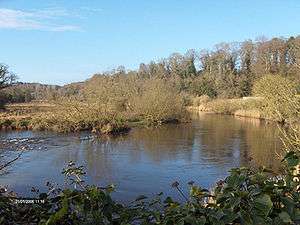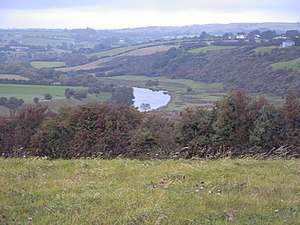Boann
Boann or Boand (modern spelling: Bóinn) is the Irish goddess of the River Boyne, a river in Leinster, Ireland. According to the Lebor Gabála Érenn and Tain Bo Fraech she was the sister of Befind[1] and daughter of Delbáeth, son of Elada, of the Tuatha Dé Danann.[2] Her husband is variously Nechtan or Elcmar. With her lover the Dagda, she is the mother of Aengus. In order to hide their affair, the Dagda made the sun stand still for nine months; therefore, Aengus was conceived, gestated and born in one day[3]; elsewhere, the Dagda kept hunger, thirst, and darkness from Elcmar during his journey, so that it only seemed to be a day for Elcmar.[4]


Etymology
Her name is interpreted as "white cow" (Irish: bó fhionn; Old Irish: bó find) in the dinsenchas, where she is also called "White Boand".[5][6] Ptolemy's 2nd century Geography shows that in antiquity the river's name was Bouvinda [Βουουίνδα],[7][8] which may derive from Proto-Celtic *Bou-vindā, "white cow".[9] An alternate version of her name is given as Segais, hence Well of Segais.[10] We are also told that Eithne was the wife of Elcmar and that another name for Eithne was Boand.[11]
Alternate names of the Boyne
In the Dindsenchas, the following names are given as equivalent to Boand:
- Segais
- The Arm and Leg of Nuada's wife
- The Great Silver Yoke
- White Marrow of Fedlimid
- Stormy Wave
- River of the White Hazel
- Banna
- Roof of the Ocean
- Lunnand
- Torrand
- Severn
- Tiber
- Jordan
- Tigris
- Euphrates
Mythology
As told in the Dindsenchas,[12] Boann created the Boyne. Though forbidden to by her husband, Nechtan, Boann approached the magical Well of Segais (also known as the Connla's Well), which was surrounded, according to the legend, by nine magic hazel-trees.[13] Hazelnuts were known to fall into the Well, where they were eaten by the speckled salmon (who, along with hazelnuts, also embody and represent wisdom in Irish mythology). Boann challenged the power of the well by walking around it tuathal; this caused the waters to surge up violently and rush down to the sea, creating the Boyne. In this catastrophe, she was swept along in the rushing waters, and lost an arm, leg and eye, and ultimately her life, in the flood. The poem equates her with famous rivers in other countries, including the River Severn, Tiber, Jordan River, Tigris and Euphrates. Additionally, it mentions alternate names for various parts of the Boyne, including River of Segais, the Arm and Leg of Nuada's wife, the Great Silver Yoke, White Marrow of Fedlimid, the River of the White Hazel, Banna, Roof of the Ocean, Lunnand, and Torrand.[14]
In a variant of the same story as told in the Dindsenchas, Boand tried to hide her infidelity with the Dagda by washing herself in Nechtan's well, but when she approaches it, it overcomes her, and she drowns.[15] She named her son Oengus (meaning one wish) because her one desire was union with the Dagda.
She also appears in Táin Bó Fraích as the maternal aunt and protector of the mortal Fráech.[16] In that story, Fráech's people tell him to go visit his mother's sister Boand to receive the raiment of the Sídhe. Boand then gives Fráech fifty intricately worked mantles and tunics with animal details, fifty jeweled spears that lit the night like the sun, fifty dark horses with gold bells, fifty swords with golden hilts, fifty swords with gold hilts, seven hounds in silver chains, seven trumpeters, three jesters, and three harpists, which Fráech uses to dazzle Medb and Ailill.[17]
She had a lapdog, Dabilla, which was swept out to sea. Torn into pieces by the water, the two halves became the rocks known as Cnoc Dabilla, or Hill of Dabilla.[18][19]
Buan
According to the story "Cormac's Adventure in the Land of Promise", there is a well in Tír na nÓg surrounded by nine purple hazel trees. Called the Well of Knowledge, it yields five streams that Manannán mac Lir later explains are the five senses from which knowledge is apprehended. The hazels, which drop nuts into a pool of five salmon, are called the hazels of Buan.[20] The combination of the well, hazels, salmon and the name Buan (meaning "enduring" or "persevering") likely points to a common origin with the story of Boand and the Well of Segais[21][22]
Another tale relates the fate of the only son of "White Buan," here identified as a male. Buan's son is named as Baile, loved by both men and women, who falls in love with Ailinn, daughter of Lugaid, son of Fergus of the Sea. The two lovers arrange a tryst, but before they can meet, Baile rests his chariot and releases his horses to graze. There he is intercepted by an unnamed character (likely Manannán in his trickster guise), described as a horrible apparition, approaching fitfully with the speed of a hawk or the wind from the green sea. When Baile asks the trickster from whence he comes and the reason for his haste, the trickster lies and tells Baile that he brings news of the death of Ailinn, who was killed by the warriors of Leinster and that she and her lover will only be reunited in death. With that news Baile drops dead on the spot, and a yew grows on his grave with the form of Baile's head at its top. The trickster moves on to intercept Ailinn, whom he tells of the death of Baile. With that news, Ailinn drops dead on the spot, and an apple tree grows on her grave with the form of her head at its top. The two trees are eventually cut down, turned into tablets, and inscribed with poems. On Halloween there was a poet's competition in Cormac's court, and the two tablets were brought together. When they met, they sprang together and intertwined as woodbine around a branch.[23]
Another Buan, named the wife of the one-armed King Mesgegra of Leinster, dies of grief after Conall Cernach beheads her husband. A hazel tree then grows through her grave.[24]
In Neopaganism
Modern-day commentators and modern paganism sometimes identify Boann with the goddess Brigid or believe Boann to be Brigid's mother;[25] however there are no Celtic sources that describe her as such. It is also speculated by some modern writers that, as the more well-known goddess, and later saint, the legends of numerous "minor" goddesses with similar associations may have over time been incorporated into the symbology, worship and tales of Brigid.[26]
In Montenegro
Boan is a town in north-western Crna Gora (Montenegro). It is widely believed to have been named after the Celtic Goddess, the Celts having resided in the region in centuries past. Another theory is that it was named after an administrative region of the ancient Persian empire. Boan is home to the Serbian Uskok clan.
References
- "The Cattle-Raid of Fraech". www.maryjones.us. Archived from the original on 2013-12-30. Retrieved 13 April 2018.
- Lebor Gabála Érenn §64 Archived 2010-07-15 at the Wayback Machine
- Tochmarc Étaíne (ed. and trans. Osborn Bergin and R. I. Best) at CELT
- The Yellow Book of Lecan “The Wooing of Etain”
- Metrical Dindshenchas, Vol 3, poem 3: "Boand II" (ed. Edward Gwynn) at CELT
- Boand I
- Karl Wilhelm Ludwig Müller (editor & translator), Klaudiou Ptolemaiou Geographike Hyphegesis (Claudii Ptolemæi Geographia), Volume 1, p. 79, Alfredo Firmin Didot, Paris (1883)
- Ptolemy, Geographia 2.1
- T. F. O'Rahilly, Early Irish History and Mythology, Dublin Institute for Advanced Studies, 1946, p. 3
- Boind II
- The Wooing of Etain "Version 1" p. 143
- Metrical Dindshenchas, Vol 3, poem 2: "Boand I" (ed. Edward Gwynn) at CELT.
- C. Squire, Celtic myth and legend, Dover Publications, p. 55, 2003.
- Boand I
- Boand II
- "The Cattle-Raid of Fraech" Archived 2013-12-30 at the Wayback Machine, trans. A. H. Leahy, Heroic Romances of Ireland Vol 2, 1906.
- unknown. "The Geste of Fraoch". Sacred Texts. Retrieved 30 November 2019.
- Clark, Rosalind (1991). The Great Queens: Irish Goddesses from the Morrígan to Cathleen Ní Houlihan. Colin Smythe. p. 137. ISBN 9780861402908.
- Coitir, Niall Mac (2015-09-28). Ireland’s Animals. The Collins Press. ISBN 9781848895256.
- Cormac's Adventure in the Land of Promise
- Wictionary "buan"
- Borlase, William Copeland (1897). The Dolmens of Ireland. Indiana University: Chapman and Hall. p. 1165. Retrieved 6 August 2019.
- Scél Baili Binnbérlaig
- The Siege of Howth
- Essay: St Brigid; Brigit's Forge: Sarasvati and Brigit part 4 Archived 2005-02-20 at the Wayback Machine
- Condren, Mary (1989) The Serpent and the Goddess: Women, Religion, and Power in Celtic Ireland. New York, Harper and Row. ISBN 0-06-250156-9 p.57